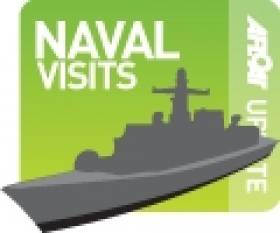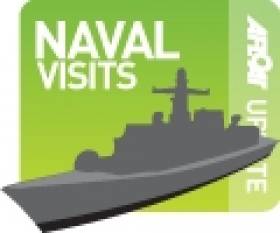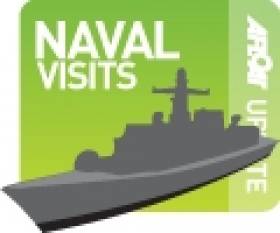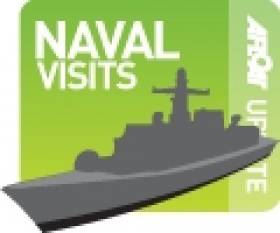Displaying items by tag: Navy Visit
Former Aircraft Carrier HMS ‘Lusty’ Open to Public Following Valentine Call
#AircraftCarrier- HMS Illustrious (R06) the Royal Navy's helicopter commando carrier is due to arrive in Liverpool on St. Valentine's Day and be open to the public next weekend (16-17 February), as part of a five-day call, writes Jehan Ashmore.
For more than three decades the former aircraft-carrier (equipped with Harrier jump-jets) has served the Royal Navy, however she is to pay-off in 2014, to make way for next generation aircraft-carriers.
Affectionately known as 'Lusty' to her crew, she is due berth alongside Liverpool Cruise Liner Terminal tomorrow at around 2pm, opposite the famous Liverpool waterfront skyline. There will be free public tours during Saturday and Sunday (10am – 4pm) noting the latest time to board is 3pm.
She forms as one of four core ships of the Royal Navy's amphibious fleet, they are the helicopter carriers HMS Ocean and assault ships HMS Albion and Bulwark, the latter is the flagship.
HMS Illustrious current role is as a High Readiness Helicopter and Commando Carrier and she is the last of the 'Invincible' class aircraft carriers commissioned for the Royal Navy during the 1970's.
As previously mentioned, the class were of course equipped with the revolutionary 'Harrier II' jump-jet VSTOL aircraft built by British Aerospace/McDonnell Douglas for the RAF, until these aircraft were retired in 2010. These days she conveys a range of helicopters, Merlin, Sea King, Apaches and Lynx for the Royal Marine Commandos.
Her sisters, the decommissioned leadship HMS Invincible (RO5) was scrapped in 2005 and HMS Ark Royal (R07), the final of the class launched in 1981 made a farewell tour around Britain in 2011. Last year it was announced that she too would be scrapped.
Merseyside based UK Patrol Boat Berths in Dublin Marina
#NAVY VISIT – The Royal Navy's coastal training patrol boat HMS Charger (P 242) spent last night in Dublin Port having sailed from Liverpool's East Brunswick Dock. The vessel is based at the Commanding Officer of the Liverpool University Royal Naval Unit RN Headquarters on Merseyside, writes Jehan Ashmore.
The small boat measuring 20m in length and a beam of 6m remains this evening moored alongside the Poolbeg Yacht Boat Club Marina. The 100-berth facility faces Alexandra Basin where P&O Cruises Arcadia docked today.
HMS Charger is an Archer P2000 class patrol boat built by Waterfcraft Ltd of Shoreham. She provides practical navigation and seamanship training at sea where a crew recruitment unit takes place annually in early October from the universities in Liverpool and also from Lancaster University.
Last week HMS Charger called to Belfast Lough which included berthing in the city's Abercorn Marina basin next to the Titanic Quarter. Also visiting the basin this week was the newbuild WFSV Gardian 10 completed by Arklow Marine Services which was on a promotional delivery voyage to Great Yarmouth.
Dutch Naval Flotilla Head for Dublin Port Visit
#DUTCH NAVAL VISIT – A torpedo training ship HNLMS Mercuur (A 900) is one of four vessels of the Royal Netherlands Navy based in Den Helder which are scheduled to visit Dublin Port next weekend, writes Jehan Ashmore.
During the four-day call, the HNLMS Mercuur and the Alkmaar class minehunter HNLMS Vlaardingen (M 863) will be open to the public on the Saturday and Sunday between 2pm-4pm. All the vessels will be berthed alongside Sir John Rogersons Quay.
HNLMS Mercuur is fitted with a maintenance shed for torpedoes and as a target ship for submarines to fire dummy torpedoes. She has an armament of 1 underwater launch tube for Mk. 48 torpedoes. The 64.8m vessel has a crew of 39 and the vessel which displaces 1,400 tonnes is powered by a 2 x MAN 6L-20/27 diesels (1,632 hp total) which deliver 14 knots.
The 41.5m long navy training ship (MOV) Van Kinsbergen (A902) is used for practical nautical training, a task for which it was specifically built and equipped. In addition to the navigation bridge, the MOV Van Kinsbergen has a second, fully equipped training bridge. There are five-crew and also the same number of civilian crew.
A second Alkmaar class vessel HNLMS Zierikzee (M862) forms the final member of the flotilla. Each of the 51.5m long vessels which weigh 534 tonnes has a crew ranging between 28-38 personnel. The Alkmaar class origin is a joint design of the Netherlands, Belgium and France navies.
The Dutch constructed the propulsion system, the Belgiums provided the electronics and the French built the mine-hunting equipment. To reflect the cooperation between the three countries, the international name of this class of ship, are referred as the Tripartite class.
Sistership of Figaro Race ‘Guardship’ to Visit
#NAVAL VISIT – A sistership of the French Naval patrol vessel that performed 'guardship' duties during last year's La Solitaire du Figaro Race to Dun Laoghaire (click HERE), is due to dock in Dublin Port in advance of St. Patrick's weekend, writes Jehan Ashmore.
PSP Pluvier (P678) is a 54m offshore patrol vessel (OPV) that belongs to a trio of the'Flamant' class, the remaining pair are the leadship PSP Flamant (P676) and PSP Cormoran (P677). The latter OPV escorted the race fleet on the second leg between Ouistreham (Caen) to Dun Laoghaire, the only international port of call of the prestigious race.
The naval visitor is the last of the sisters built and was constructed in Cherbourg at Chantier des Constructions Mécaniques de Normandie (CMN). She entered service in 1997 and carries out patrols in seas up to 200 nautical miles offshore of the French économique exclusive zone (ZEE).
She is scheduled to arrive on Thursday afternoon and berth at Sir John Rogersons Quay, downriver from the Samuel Beckett swing-bridge.

































































